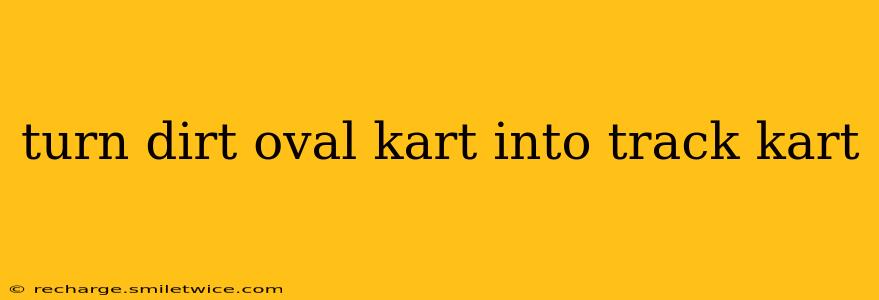Converting a dirt oval kart into a track kart is a significant undertaking, requiring more than just a few bolt-on modifications. It's a project that demands careful planning, precision, and a solid understanding of karting dynamics. This guide will walk you through the key considerations and steps involved in this transformation.
What are the Key Differences Between Dirt Oval and Track Karts?
Before diving into the modifications, it's crucial to understand the fundamental differences between these two types of karts. Dirt oval karts are built for high-speed, sustained cornering on loose surfaces. They typically feature:
- Wider tracks: Providing greater stability on loose surfaces.
- Higher ride height: Allowing for better ground clearance and bump absorption.
- More aggressive gearing: Optimized for acceleration and maintaining momentum.
- Different tire compounds: Designed for grip on dirt.
- Heavier chassis: Often constructed from heavier gauge steel for durability.
Track karts, conversely, are designed for precision handling and speed on paved surfaces. They emphasize:
- Narrower tracks: For improved responsiveness and cornering.
- Lower ride height: For better aerodynamic efficiency and reduced center of gravity.
- More precise gearing: For optimal acceleration and top speed on a smooth track.
- Slick tires: Designed for maximum grip on pavement.
- Lighter chassis: Often constructed from lighter materials like aluminum for improved handling.
What Modifications are Needed to Turn a Dirt Oval Kart into a Track Kart?
The transformation is extensive and often requires more than just a simple parts swap. Here's a breakdown of the key areas:
1. Chassis Modification:
This is arguably the most challenging aspect. Simply lowering the ride height of a dirt oval chassis may not be sufficient and could compromise structural integrity. Consider these possibilities:
- New Chassis: The most comprehensive (and expensive) approach is to purchase a new chassis specifically designed for track racing.
- Professional Modification: A reputable kart chassis builder can potentially modify your existing chassis, but this can be costly.
- Limited Modifications: For a more budget-friendly approach, you may be able to adjust the ride height, potentially requiring welding and adjustments to the suspension mounting points. However, this route may compromise handling characteristics.
2. Suspension Adjustments:
The suspension setup needs a complete overhaul. This involves:
- Lowering the ride height: Crucial for reducing the center of gravity and improving handling.
- Adjusting spring rates and damper settings: To accommodate the change in ride height and surface conditions.
- Replacing axles and hubs: To align with the narrower track width needed for track racing.
3. Gearing Changes:
The gearing ratio needs to be adjusted to optimize acceleration and top speed on a paved track. This usually involves:
- Changing the sprockets: Front and rear sprockets will need modification or replacement to match the requirements of a track kart.
- Consider a different chain: The chain may need replacement due to the different sprocket sizes.
4. Tire Selection:
Dirt oval tires are completely unsuitable for track racing. You'll need to acquire high-performance slick tires appropriate for your kart's size and the type of track surface.
5. Brake System Evaluation:
The brake system might need an upgrade to handle the higher speeds and increased stopping power required on a track.
What About the Engine?
While the engine itself might not need complete replacement, you might want to consider:
- Carburation Adjustments: Fine-tuning the carburetor will be necessary to optimize performance with the new gearing and tire setup.
- Exhaust System: An optimized exhaust system for track use could significantly improve performance.
How Much Does It Cost to Convert a Dirt Oval Kart to a Track Kart?
The cost varies dramatically depending on the extent of the modifications. A partial conversion, involving only adjustments to the existing chassis, might cost a few hundred dollars. A complete rebuild, including a new chassis and all components, could easily reach several thousand dollars.
Is It Worth Converting a Dirt Oval Kart to a Track Kart?
This depends entirely on your budget, mechanical skills, and long-term goals. If you have a limited budget and enjoy DIY projects, a partial conversion might be a feasible option. However, a full conversion may not be cost-effective compared to buying a used track kart.
This comprehensive guide highlights the challenges and considerations involved in converting a dirt oval kart into a track kart. Carefully weigh the costs, effort, and potential outcome before embarking on this project. Good luck!
